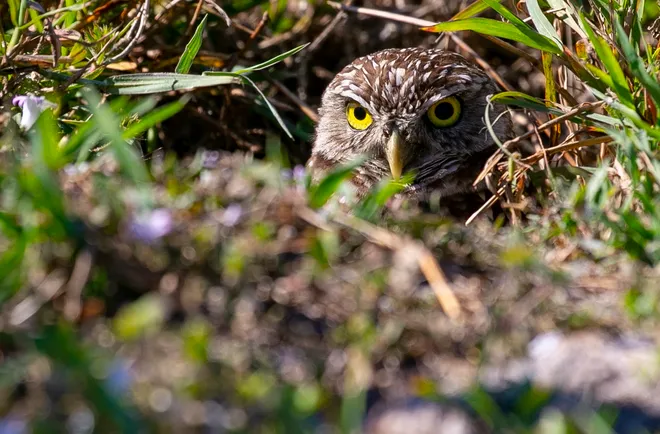Early birds: Burrowing owl nesting season reaches its peak
The burrowing owl nesting season is hitting its peak, just in time for some public celebrations centered around Cape Coral’s official bird.
More than 3,000 of these pint-sized birds can be found in the city, and support groups and government organizations hold events to raise public awareness about the threatened species.
“The babies are starting to pop up, but there is increasing pressure to build and that puts more pressure on nesting owls,” said Janet Windisch, spokeswoman for Cape Coral Friends of Wildlife. “We’re trying to purchase land as fast as we can and we’re trying to get people to start burrows in their yard. That’s our defense against loss of habitat.”
Breeding season is typically Feb. 15 through July 10, although the local population appears to be nesting early this year, Windisch said.
Listed at threatened by the Florida Fish and Wildlife Conservation Commission, or FWC, burrowing owls moved to the Cape Coral area in droves during the 1960s, when the area was cleared of trees and canals cut to help drain the land. FWC is the state agency charged with protecting threatened and endangered animals, such as the burrowing owl.
Tiny owls known for large yellow eyes
The population here has grown since, with the owls making nests on cleared lots, even road medians.
Burrowing owls are among the smallest of owls in the Sunshine State, and they’re known for their large yellow eyes, brown back feathers and white chins.
“The burrowing owl spends most of its time on the ground, where its sandy brown plumage provides camouflage from potential predators,” and FWC website reads. “It averages nine inches in height with a wingspan of 21 inches. The burrowing owl lacks the ear tufts of the more familiar woodland owls. Unusually long legs provide additional height for a better view from its typical ground-level perch.”
Chicks can fly at six weeks old
Several eggs are laid by the females, with white juveniles born several weeks later.
“Females lay up to eight eggs within a one-week period, and they will incubate the eggs for up to 28 days,” an FWC website says. “Once the white-feathered juveniles are born, it takes two weeks before they are ready and able to appear out of the burrow. Juveniles will begin learning how to fly at four weeks, but will not be able to fly well until they are six weeks old.”
Windisch said the best way to see burrowing owls is to visit parks like the Pelican Baseball Complex and the Cape Coral library.
“If you pull off the side of the road or an empty lot, sometimes the burrowing owls are in the median or right up against the road,” Windisch said.

A burrowing owl peeks its head above ground. The city of Cape Coral celebrated its fifth annual Ground Owl Day event at Pelican Baseball Complex, on Thursday, February 2, 2023. This is the middle of nesting season, and another winter ceremony will be held Friday, with the annual Burrowing Owl Festival taking place on Feb. 24.
